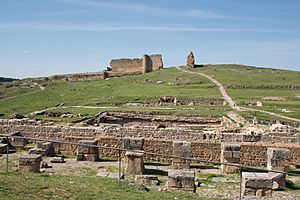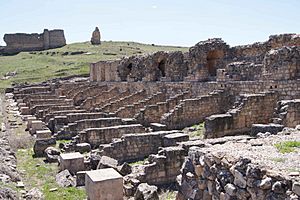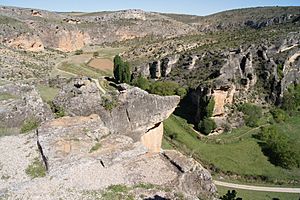Valeria, Spain (Roman city) facts for kids

The Roman city
|
|
| Location | Spain |
|---|---|
| Region | Castile–La Mancha |
| Coordinates | 39°48′30″N 2°09′01″W / 39.8083°N 2.1503°W |
Valeria was an important Roman city in ancient Spain. It was one of the three main cities in the area that is now the province of Cuenca. The other two were Segobriga and Ercavica.
Today, you can visit its amazing ruins. They are located in a beautiful spot near the modern town of Valeria, in Castilla-La Mancha.
Contents
Uncovering Valeria's Past
Valeria was built on land that the Romans took from the celtiberians, an ancient people of Spain. The city was founded between 93 and 82 BC. It was named after its founder, a Roman leader named Valerius Flaccus. He was a proconsul, which was like a governor, of a Roman province called Hispania Citerior.
Exploring the Ancient City Site
Valeria is built on a narrow piece of land high up in the mountains, about 1000 meters (over 3,200 feet) above sea level. It is surrounded by deep limestone gorges.
People started digging at the site in the 1950s. Since 1974, archaeologists have been doing more scientific excavations. They have mainly focused on the city's main public square, called the forum, and some private homes.
Most of Valeria's big buildings were constructed in the 1st century AD. This is when the forum was built. The center of the city had many public buildings around a huge square platform. The forum itself stood in the middle of this platform. It is one of the most complete Roman forums built on a raised platform.

Underneath the platform, there were large underground tanks called cisterns. These cisterns collected rainwater from above, storing it for the city's use.
On the north side of the forum was the Basilica, a large public hall. On the west side, you would find the Exedra and the Cryptoporticus. The Exedra was a hall used for worshipping the Roman emperors. The Cryptoporticus was a vaulted, underground passage. It served as a street or storage area and also supported the floor of the Exedra.
To the south of the forum, there was a grand staircase leading up to it. There were also a series of shops. The most famous building in Valeria, the Nymphaeum, was also here. It was over 100 meters (about 330 feet) long. The entire area was surrounded by streets. The size and quality of these remains show that Valeria was an important Roman town, known as a Municipium.
The Nymphaeum: A Grand Fountain
On the east side of the forum, you can find the Nymphaeum. This was a very unique and large fountain building. It was dedicated to nymphs (nature spirits) and rivers. It is over 105 meters (344 feet) long, with more than 80 meters (262 feet) being the fountain part itself. This makes it one of the largest Roman fountains ever found, especially in Spain.
The Nymphaeum might not have been part of the very first forum. It was probably added when the forum was rebuilt and raised in the 1st century AD, during the time of Emperor Claudius. It is a very old example of such a fountain, built early in the 1st century AD.
The ground on this side of the forum dropped sharply. So, a tall retaining wall was needed to hold back the hillside. The builders used this wall to create a beautiful shrine to water gods. This was a common idea in the local Celtiberian culture. In front of the wall, which was decorated with niches, shops were built. The roofs of these shops formed a long terrace at a lower level of the forum. This terrace offered a great view of the city.
A long passage ran behind the terrace. It had a channel connected to the city's water tanks. Water flowed from this channel through openings in the decorated niches. Statues or paintings might have been in these niches. The water then flowed into ornate fountains below. The system for supplying and collecting water was very advanced, even though little of it remains today.
The Nymphaeum is truly the most special monument in Valeria. It is one of the most famous and recognizable ancient sites in Spain. By the 4th century AD, the Nymphaeum was no longer used and was likely damaged. The area was later used for simple private homes and as a source of building materials.
The Exedra: A Changing Space
The Exedra was a public building connected to the Cryptoporticus, the underground passage. In its early days, people could go between the two through doors. The Exedra itself was entered from the street through two doors on its east side.
Over time, the Exedra changed its purpose. In the 2nd century AD, during a renovation, the doors to the Cryptoporticus were blocked. Later, in the 3rd century, the forum became ruined and was no longer a public space. By the 4th century, the Exedra was used as a private home. People had to build stairs to reach the ground floor because of fallen debris. Walls were also rebuilt, and door openings were changed to create different rooms.
Other Buildings and Discoveries
On the south side of the forum, there is a building called the "House of the Adobe." Another example of a private home is the "Casa del Hoyo."
The Roman city had a very good water supply system. It used aqueducts, which were channels carved into the rock, to bring water to the city.
Many objects found at Valeria are now in the museum of Cuenca. These include the "treasure of Valeria," which is a collection of silver coins. These coins date back to about 185 BC, after the Second Punic War.
See also
 In Spanish: Valeria (ciudad romana) para niños
In Spanish: Valeria (ciudad romana) para niños




